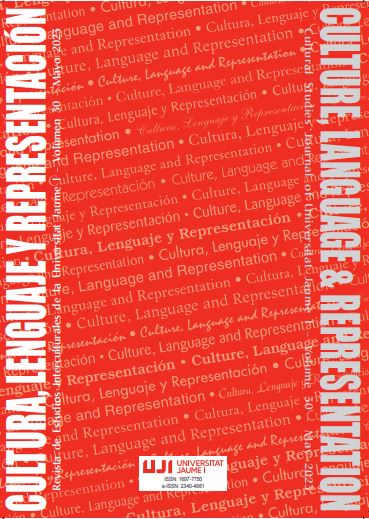Evolution of assisted reproduction terminology in Spanish language dictionaries and corpora
Main Article Content
Abstract
Medical terminology is a historical product whose creation and evolution involves not only scientific, but also social and cultural factors. Based on this premise and taking the TERMMED Project as a reference, the aim of this paper is to study the terminology of the field of assisted reproduction (AR) in order to understand its evolution, to determine how this evolution depends on and feeds back into the social context in which it takes place, and to observe its rate of dictionarization in the Spanish academic dictionary. As one of the discourses that best shows the changes experienced by any area of reality is the dictionary, firstly, the entries of a representative selection of AR terms in various editions of the academic dictionary of Spanish are analyzed. Secondly, the first appearance of these words in the most representative textual corpora of Spanish, their frequency of use and the interest of the general population in consulting them, are also analyzed. The results show the social importance that AR has been acquiring and the mismatch between the rate of dictionarization of these units and the needs of the speakers reflected in the corpora of use and in the consultations to the dictionary.
Downloads
Article Details
An open-access CREATIVE COMMONS copyright license is used. Those authors whose works are published by this journal, accept the following terms:
- Authors will retain their copyright and guarantee the Journal the right to first publish their work, which will simultaneously be subject to the Creative Commons Recognition License CC BY SA that allows third parties to share the work, provided that its author and first publication is indicated.
- Authors may adopt other non-exclusive license agreements for the distribution of the published version of the work (e.g., deposit it in an institutional telematics file or publish it in a monographic volume) provided that the initial publication in this journal is indicated.
- Authors are allowed and recommended to disseminate their work over the Internet (e.g. in institutional telematics files or on their website) before and during the submission process, which can produce interesting exchanges and increase quotes of the published work.
Funding data
-
Agencia Estatal de Investigación
Grant numbers FF12017-88100-P -
European Regional Development Fund
Grant numbers FF12017-88100-P
References
Barona, Josep Lluís. 2004. «Hacer ciencia de la salud: los diagnósticos y el conocimiento científico de las enfermedades». Panace@. Revista de Medicina, Lenguaje y Traducción, 15: 37-44. https://www.tremedica.org/wp-content/uploads/n15_tribuna-Barona.pdf.
Díaz Rojo, José Antonio. 2005. «Terminología médica, cultura e ideología». Quaderns de Filologia. Estudis Lingüístics, X: 31-51. https://ojs.uv.es/index.php/qfilologia/article/view/5079/4873.
Domènech-Bagaria, Ona, Rosa Estopa e Isabel Santamaría-Pérez. 2022. «La terminología de la reproducción asistida en los diccionarios». En La terminologia, espejo de la evolución del conocimiento científico: El caso de la reproducción asistida, ed. Rosa Estopà y Mercè Lorente. Serie Monografies 15. Barcelona: Institut de Lingüística Aplicada de la Universitat Pompeu Fabra y Documenta Universitària.
Estopà, Rosa. 2012. «Medicina i llenguatge: les paraules de la salut». Llengua, societat i comunicación, 10: 1-5. https://doi.org/10.1344/LSC-2012.10.1.
Estopà, Rosa y Mercè Lorente (ed.). 2022. La terminologia, espejo de la evolución del conocimiento científico: El caso de la reproducción asistida. Serie Monografies 15. Barcelona: Institut de Lingüística Aplicada de la Universitat Pompeu Fabra y Documenta Universitària.
Guardiola, Elena y Josep-Eladi Baños. 2011. «Eponímia mèdica. Els altres epònims». Annals de Medicina, 94: 130-132. https://raco.cat/index.php/AnnalsMedicina/article/view/283218.
López Gálvez, José Jesús y Juan Manuel Moreno García. 2015. «¿“Industria de la fertilidad” o respuesta a la búsqueda del hijo biológico?». Boletín del Ministerio de Justicia, monográfico “Treinta años de reproducción asistida en España: una mirada interdisciplinaria a un fenómeno global y actual”, 2179: 239-252. https://www.mjusticia.gob.es/es/AreaTematica/DocumentacionPublicaciones/InstLibraryDoctrinalStudies/1506_30_a%C3%B1os_de_reproduc_asistida_MARC.pdf.
Sánchez, Ana. 2005. «Las tecnologías de reproducción asistida y sus metáforas». Arbor, 716: 523-530. https://doi.org/10.3989/arbor.2005.i716.409.
Sociedad Española de Fertilidad. 2011. Saber más sobre fertilidad y reproducción asistida. Madrid: SEF. https://www.sefertilidad.net/docs/pacientes/spr_sef_fertilidad.pdf.
Trabulse, Elías. 1987. La ciencia en el siglo XIX. México D. F.: Fondo de Cultura Económica. http://www.librosmaravillosos.com/la_ciencia_en_el_Siglo_XIX/.
Zegers-Hochschild et al. 2017. «The International Glossary on Infertility and Fertility Care, 2017». Human Reproduction, 32(9): 1786-1801. https://www.ncbi.nlm.nih.gov/pmc/articles/PMC5850297/.
DICCIONARIOS Y CORPUS TEXTUALES
[DLE] Real Academia Española. Diccionario de la lengua española, 23ª ed. [versión 23.3 en línea]. https://dle.rae.es.
[DTM] Real Academia Nacional de Medicina. 2012. Diccionario de términos médicos. Madrid: Editorial Médica Panamericana. https://dtme.ranm.es/index.aspx
[GTRA] Zegers-Hochschild et al. 2010. «Glosario de terminología en Técnicas de Reproducción Asistida (TRA). JBRA, Assisted Reproduction, 14(2): 19-23. https://cnrha.sanidad.gob.es/documentacion/bioetica/pdf/Tecnicas_Reproduccion_Asistida_TRA.pdf
[CORDE] Real Academia Española. Corpus diacrónico del español. http://www.rae.es
[CORPES] Real Academia Española. Corpus del Español del Siglo XXI. http://www.rae.es
[CREA] Real Academia Española. Corpus de Referencia del Español Actual. http://www.rae.es


